Dedicated oenologists take great pride in identifying a vintage year. Fans of the American musical theatre, similarly often look to Ethan Mordden for a detailed history of Broadway musicals. Among Mordden's best-selling books is Coming Up Roses: The Broadway Musical in the 1950s.
While few would argue that the 1950s represented the Golden Age of Broadway musicals, if one examines the list of shows that were playing on the Great White Way in 1956 and 1957, the results are jaw-dropping. The only revivals (Brigadoon and Carousel) were presented by the New York City Center under the auspices of Jean Dalrymple. The new shows included:
- Fanny
- Candide
- Jamaica
- L'il Abner
- Pipe Dream
- My Fair Lady
- Silk Stockings
- Damn Yankees
- Mr. Wonderful
- Shinbone Alley
- Happy Hunting
- The Music Man
- Plain and Fancy
- West Side Story
- Bells Are Ringing
- The Pajama Game
- New Girl In Town
- New Faces of 1956
- The Most Happy Fella
- Ziegfeld Follies of 1957
These days revivals and jukebox shows often outnumber new musicals. Thankfully, regional theatre and opera companies view the literature of Broadway as part of an American heritage that deserves attention. This summer, I was lucky enough to attend Bay area productions of three great musicals from the golden years of 1956 and 1957.
* * * * * * * * * *
It goes without saying that My Fair Lady is one of the most beloved musicals of the 20th century. But what I love about a website like the Internet Broadway Database is the kind of trivia that can be found by poking around the list of replacement casts during a show's run. Who knew that on December 23, 1957, the Queen of Transylvania was played by Kay Kendall (Rex Harrison's new wife)? Or that her escort at that performance was played by none other than the show's director, Moss Hart?
Woodminster Summer Musicals recently offered a revival of My Fair Lady at the Woodminster Amphitheatre in Oakland's Joaquin Miller Park. Directed by Joel Schlader and choreographed by Peggy Nixon, this sturdy staging makes excellent use of the ramp that encircles the outdoor theatre's orchestra pit.
Having attended a performance of Billy Elliot the Musical two nights prior, in which the amplification was so loud that I thought my head might explode, it was especially gratifying to listen to Frederick Loewe's gracefully melodic score and Alan Jay Lerner's exquisitely-crafted lyrics again. Based on George Bernard Shaw's 1923 comedy, Pygmalion, My Fair Lady has lost none of its bite in the 55 years since it premiered on Broadway.
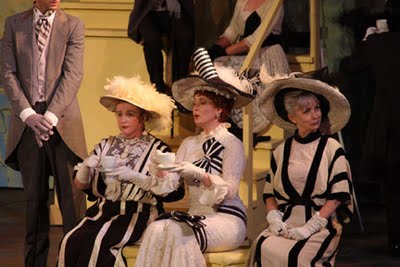
Mrs. Eynsford Hill (Theresa DeLargy), Eliza Doolittle (Susan Himes Powers)
and Mrs. Higgins (Lucinda Hitchcok Cone) enjoy a cup of tea
at the Ascot Racetrack in My Fair Lady (Photo by: Kathy Kahn)
Robert Moorhead was perfectly cast as Professor Henry Higgins, with Gene Brundage providing a strong counterpart as Colonel Pickering. Lucinda Hitchcock Cone scored as Mrs. Higgins while Avi Jacobson was an unctuous Zoltan Karpathy.
Greg Carlson's boisterous portrayal of Alfred P. Doolittle was a delight, offering a stern reminder of Shaw's dry wit in depicting the challenges faced by the common man who can't afford modern middle-class morality. Jarrett Battenburg's lean and lanky Freddy Eynsford-Hill displayed some strange vocal phrasing (as if he were almost afraid to relax and indulge the music's lyrical line).
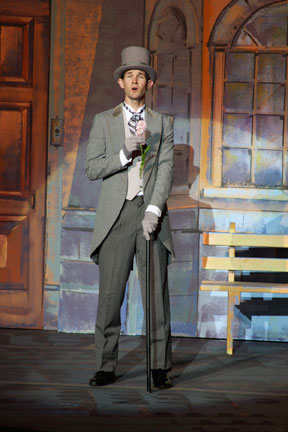
Jarrett Battenburg as Freddy Eynsford-Hill sings "On The Street
Where You Live" in My Fair Lady (Photo by: Kathy Kahn)
The evening's greatest delight was Susan Himes Powers, who was making her debut in the role of Eliza Doolittle. An artist who possesses an exceptionally well-placed lyric soprano, Ms. Himes Powers is also a deft comedienne with superb diction who is fully capable of handling Eliza's Cockney accent with clarity and pathos while imbuing her subsequent dramatic moments with a great sense of dignity.
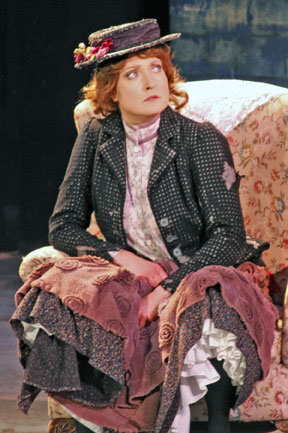
Susan Himes Powers as Eliza Doolittle
in My Fair Lady (Photo by: Kathy Kahn)
The bittersweet joy that accompanies any revival of My Fair Lady is the realization that, back in 1956, it was fairly common for a Broadway musical to introduce a handful of songs that became popular standards. Looking at Act I of My Fair Lady, one finds five songs that instantly became popular hits ("Wouldn't It Be Loverly?" "With A Little Bit of Luck," "The Rain in Spain," "I Could Have Danced All Night," and "On the Street Where You Live"). Act II contains "Get Me To The Church On Time" and "I've Grown Accustomed To Her Face." Talk about craft! They just don't make 'em like that anymore.
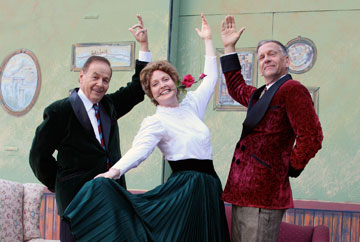
Colonel Pickering (Gene Brundage), Eliza Doolittle (Susan Himes Powers)
and Professor Henry Higgins (Robert Moorhead) sing
"The Rain in Spain" in My Fair Lady (Photo by: Kathy Kahn)
* * * * * * * * * *
In his book, Coming Up Roses: The Broadway Musical in the 1950s, Ethan Mordden writes:
"The Most Happy Fella enjoys a great diversity in the structure of its music. Loesser mixes pop and legit, arioso and recit, underscored dialogue: this is a demonstration piece of how many different techniques Broadway had developed for music theatre by 1956. If My Fair Lady hadn't opened six weeks before, The Most Happy Fella would have been the official glory of the mid-1950s. There is only one greater score in this decade, that of Candide -- and even Candide is not as emotionally elaborated as The Most Happy Fella ."
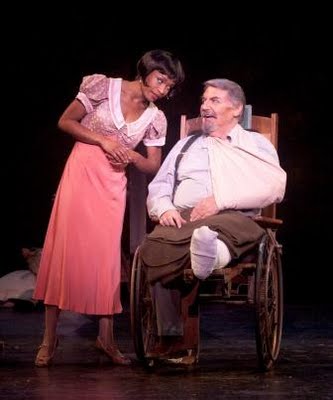
Shawnette Sulker and Ted Weis in Festival Opera's
2011 production of The Most Happy Fella
(Photo by: Robert Shomler)
Since its original Broadway production (which was partially funded by Lucille Ball and Desi Arnaz), Frank Loesser's musical has been widely hailed for its musicianship as well as the fact that its original cast album required three LPs to accommodate the show's 40-plus musical numbers. The Most Happy Fella (along with 1964's Anyone Can Whistle) is one of the few Broadway musicals to be broken into three acts. It is also a show that easily straddles any perceived boundaries between opera and musical theater.

José Hernandez (Ciccio), Michael Mendelsohn (Giuseppe), and
Nicholas Aliaga (Pasquale) in Festival Opera's 2011 production
of The Most Happy Fella (Photo by: Robert Shomler)
Revivals, however, have been far less frequent than those of My Fair Lady. I first saw The Most Happy Fella at a New York City Center revival that featured Karen Morrow as Cleo and Art Lund repeating his portrayal of Joe. In September 1979, Michigan Opera Theatre's production traveled to Broadway's Majestic Theatre for a limited run. That production was recorded by PBS and aired nationally in 1980 as part of its Great Performances series. In the following video clip, Giorgio Tozzi and Sharon Daniels sing "My Heart Is So Full of You."
In 1991, the New York City Opera presented The Most Happy Fella with a cast headed by Louis Quilico with Karen Ziemba appearing as Cleo. That same year, the Goodspeed Opera House staged a production accompanied on two pianos (using a score that Loesser had once commissioned) with such success that the production moved to Broadway's Booth Theatre in 1992 with Spiro Malas as Tony (it ran for 229 performances). In 2006, the New York City Opera revived The Most Happy Fella with Paul Sorvino in the title role.
The source material for The Most Happy Fella was Sidney Howard's play, They Knew What They Wanted, which won the 1925 Pulitzer Prize for Drama. In 1940, Garson Kanin directed a film version of Howard's play that starred Charles Laughton as Tony, Carole Lombard as Amy, Lee Tung Foo as a Chinese cook named "Ah Gee" and marked the screen debut of a young Karl Malden. In the following clip, Brian Staufenbiel (the artistic director of the opera program at UC-Santa Cruz who staged Festival Opera's 2011 revival of The Most Happy Fella) discusses what made the show so innovative half a century ago:
Peter Crompton's sets for The Most Happy Fella used a style of art found on old-fashioned postcards of California to invoke a nostalgic sense of San Francisco and the Napa Valley. With Bryan Nies on the podium, the production was solidly cast from the minor roles (the three singing Italian waiters) through to Krista Wigle's buxom, brassy Cleo and Pierce Brandt's delightful and athletic Herman.
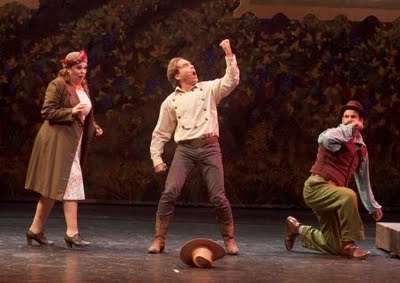
Cleo (Krista Wigle) and Herman (Pierce Brandt) in a scene from
Festival Opera's 2011 production of The Most Happy Fella
(Photo by: Robert Shomler)
Outfitted with body mikes, the three romantic leads delivered convincing portrayals of their complex characters. As Tony, Ted Weis sang with a remarkably healthy voice for a man of his age. Joshua Hollister's Joe seemed younger and less jaded than most (the appealing young baritone's singing was much stronger than his acting). Shawnette Sulker's Rosabella was extremely moving, her voice soaring in key moments of passion.
The musical riches in Loesser's score never fail to amaze audiences. From big production numbers like the title song and "Big D" to tender ballads like "Somebody, Somewhere," "Joey, Joey, Joey," and "Don't Cry" -- from comedy numbers like "Ooh, My Feet," "Abbondanza," "Good-bye, Darlin'" and "I Like Everybody," to songs of remarkable intimacy ("How Beautiful The Days" and "Warm All Over"), The Most Happy Fella overflows with a wealth of creativity.
I can think of no better example to demonstrate how well this show's songs stand the test of time than this clever musical trailer (that was shot locally) featuring the show's biggest hit: "Standing on the Corner."
* * * * * * * * * *
Down on the Peninsula, Broadway by the Bay seems quite happily ensconced in its new home, the Fox Theatre in Redwood City. Although hardly as lavish as some of the old Fox movie palaces, the Redwood City auditorium has the kind of intimacy and acoustics that eluded the company in its previous venue, the San Mateo Performing Arts Center. Between the theatre and the San Mateo County History Museum is an old-fashioned town square which was hosting a free outdoor screening of 2002's popular animated feature, Ice Age, on the night I attended a performance of Meredith Willson's 1957 hit, The Music Man.
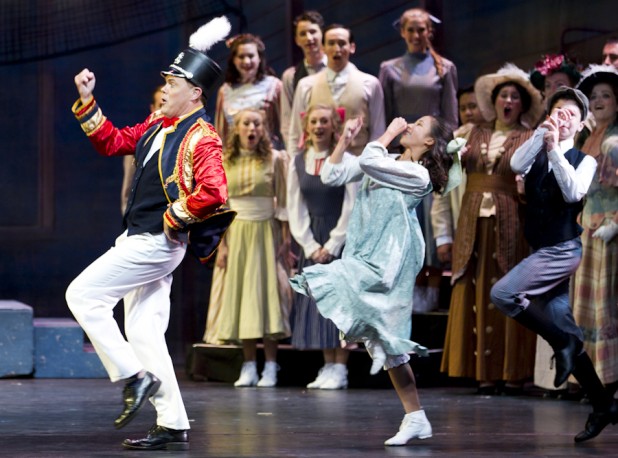
Professor Harold Hill (Tom Reardon) sings "76 Trombones" in
Broadway By The Bay's production of The Music Man
Photo by: Mark Kitaoka
The Music Man holds a very special place in my heart. It was the second Broadway show I attended (the first was Plain and Fancy), and I remember being thrilled by the opening moments in which clouds of stage fog billowed through a painted scrim depicting an old-fashioned steam locomotive. The show's opening number, "Rock Island," was nothing short of revolutionary at the time. During his recent stint at the Curran Theatre, Hugh Jackman sang the entire number (designed for a chorus of traveling salesmen) all by himself.
With book, music, and lyrics by Meredith Willson, the show is a model of theatrical economy and stagecraft. Scene transitions are quick and easy. Musical numbers neatly move the plot forward. Some of the show's biggest production numbers ("Marian the Librarian" and "Shipoopi") are carried forward by a kind of American optimism that is not just infectious, but painfully absent from our current cultural landscape.
Willson's score includes such foot-tapping numbers as "76 Trombones" and "The Wells Fargo Wagon" along with songs of wistful longing, like "Goodnight, My Someone," "My White Knight," "Will I Ever Tell You" and "Till There Was You." The traditional appeal of barbershop quartet numbers like "Good Night, Ladies," "Sincere," "It's You," and "Lida Rose" is neatly balanced against novelty numbers like "Pick-a-little, Talk-a-little," "The Sadder But Wiser Girl," and "Gary, Indiana."
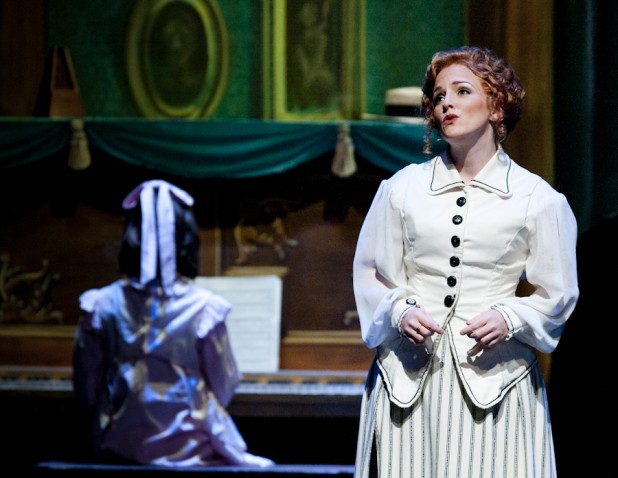
Kerie Darner-Moss as Marian Paroo (Photo by: Mark Kitaoka)
The Music Man is also one of the few shows during which I can always feel hot tears quietly running down my cheeks. This happens during specific moments (Winthrop's sudden outburst: "Thithter, thithter, ithn't thith cornet the motht thcrumpthiouth thing you've ever theen?") or during those parts of the script when Willson's dramatic craft becomes so evident, and his writing so clean, that your realize you'd need a wrecking ball to dent a hole in his show.
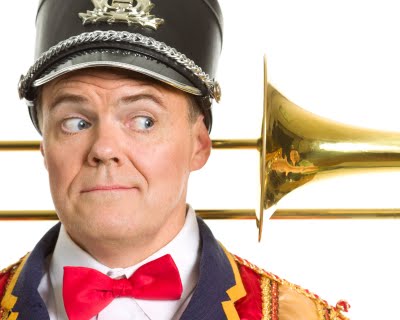
Tom Reardon as Professor Harold Hill in The Music Man
Photo by: Mark Kitaoka
A familiar face to Bay area audiences, Tom Reardon portrayed Harold Hill as a mischievous scamp who had always managed to get by on his looks and charm until a feisty librarian turned the tables on him. As Marian Paroo, Kerie Darner-Moss displayed a strong lyric soprano. Claudia McCarley brought a matronly Irish twang to the role of Mrs. Paroo while Trevor Wright's dancing added grace and humor to the role of Tommy Djilas.
Supporting roles were solidly cast with Mark Alabanza as Marcellus Washburn, Scott Stanley as the anvil salesman, Charlie Cowell; Linda Piccone as the Mayor's wife, Eulalie MacKecknie Shinn; and David Gahagen as her blustering husband. Some of the evening's best musical work came from the barbershop quartet (David Lloyd Pias as Ewart Dunlap, Ryan Baum as Jacey Squires, Mark Waldman as Oliver Hix, and especially bass-baritone David Murphy as Olin Britt).
Using sets and costumes rented from the Fullerton Civic Light Opera, Lee Ann Payne kept the stage direction nice and brisk, with Attilio Tribuzi putting the pit band through its paces. To suggest that a good time was had by all would be a severe understatement.

Tom Reardon as Professor Harold Hill with
Kerie Darner-Moss as Marian Paroo in The Music Man
Photo by: Mark Kitaoka
To read more of George Heymont go to My Cultural Landscape
